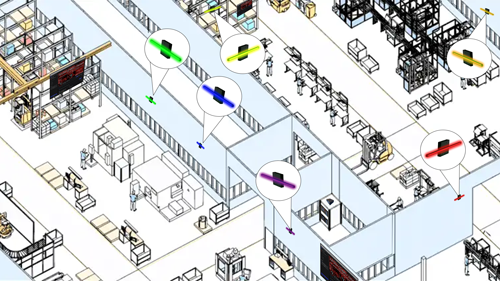Lumalert Lights Up Factory Alerts
Nov. 17, 2025
Today’s factory floors often have too much noise for audio alerts to be effective. Lumalert solves that issue, featuring a bright color LED bar triggered by commands over an Ethernet network. In fact, manufacturing visual alerts are so prevalent that there’s an ISO 3864 standard for colors and flashing. Response is immediate as each effect is stored as a preset in memory, and a command can be sent to all, a group, or one Lumalert. PoE provides power, so installation is simpler.

For example, Lumalert fixtures across the factory could indicate:
- Green – machine working properly
- Blue - preventative maintenance due soon
- Red – Machine/Robot offline
- Yellow - backlog in unit testing
- Orange - parts inventory running low
- Purple – quality control issue
- Cyan – Unsafe conditions such as high noise, air quality, and temperature
Taking Control
A Lumalert fixture features an 18” high-output color LED bar. The compact base mounts with 2 screws to a surface or a 2-gang electrical box. Inside the base is an RJ45 Ethernet connector, an RS-232 port for local programming, closure inputs for local preset triggering, and a 12V power input (if needed).
Setup
Two DIP switches on the back set the unit’s unique device number. The first defines the zone, the second sets the individual number.
Once installed on the network and powered up, the installer can scan and discover all the Lumalert fixtures using the free LA Toolbox software. Each has an onboard Web page for testing and setup.
When all units are online, select one and set up the site presets. Then click an option on the Web page to update all the units (feature coming soon).
Commands
System commands should be familiar to CR integrators – sent as an IP broadcast to all, containing the device number and preset number. There are three types of device numbers: a specific device number, all devices (4095), or a Zone number (256, 512, etc.) that triggers all units within that zone.
AV Integrators are uniquely qualified to create an interactive visual signaling system. A custom control solution adds the ability to receive data from touch screens, assembly machines, and robots, as well as security and environmental systems. From that data, the control system applies logic, then sends Lumalert preset commands across the network.
ISO 3864 Alert Standards
This standard states colors and effects for alerts in manufacturing spaces. While most sites won’t use all the available options, the standard allows consistency of alerts for management and workers in the industry.
Safety and Emergency Alerts
These prioritize worker protection and rapid response to hazards, which are common in factories involving heavy machinery, chemicals, or high-risk processes.
- Red (flashing) - Emergency Stop or Hazard Detection. Indicates an immediate danger, such as a machine malfunction, chemical spill, or detected gas leak. Workers can quickly evacuate or shut down operations, reducing injury risks.
- Alternating Red/White - Evacuation or Fire Alert. Signals the need to clear the area due to fire, explosion risk, or structural failure. This ensures coordinated evacuation without confusion.
- Amber (flashing) Personal Injury or Medical Emergency: Alerts nearby staff to assist an injured worker, perhaps integrated with wearable sensors. It helps summon first aid teams promptly.
Operational and Machine Status Alerts
Factories often have multiple machines running simultaneously, so visual indicators help monitor performance without constant manual oversight.
- Red – Machine Downtime or Breakdown. Notifies maintenance teams of a stopped or faulty machine, minimizing production delays. For example, if a conveyor belt jams, the light changes to alert operators.
- Blue - Preventive Maintenance Needed. Warns that a machine is approaching a service interval (e.g., based on runtime hours or sensor data). This prevents unexpected failures and extends equipment life.
- Green - Normal Operation. Confirms everything is running smoothly, allowing workers to focus elsewhere. A shift to yellow could indicate minor issues like overheating before they escalate.
Production and Workflow Alerts
These optimize throughput, quality, and efficiency on assembly lines or production zones.
- Yellow - Production Slowdown or Bottleneck. Highlights delays in a specific section, such as a backlog at quality inspection. Supervisors can reallocate resources to resolve it quickly.
- Purple - Quality Control Issue. Flags defective products or process deviations (e.g., via integrated cameras or sensors). This prevents faulty items from advancing, reducing waste and rework.
- White or Green flashing - Target Achievement or Milestone. Celebrates meeting quotas or completing a batch, boosting morale and signaling the start of the next phase.
Inventory and Resource Alerts
In just-in-time manufacturing, timely alerts prevent stockouts or overstocking.
- Orange - Low Inventory or Supply Shortage. Indicates when raw materials, parts, or tools are running low (triggered by inventory sensors). Workers can reorder or switch tasks to avoid halts.
- Yellow flashing - Waste or Overflow Alert. Warns of overfilled bins or excessive scrap buildup, promoting lean practices and maintaining a clean workspace.
Environmental and Compliance Alerts
Factories must monitor conditions to comply with regulations and ensure worker comfort.
- Cyan - Environmental Hazard. Signals unsafe conditions like high noise levels, poor air quality, or extreme temperatures/humidity. This prompts ventilation adjustments or breaks.
- White flashing - Shift Change or Break Time. Reminds workers of scheduled breaks, shift ends, or handovers, helping maintain fatigue management and compliance with labor laws.
